
|
|||||||||||||||
|
| |||||||||||||||
Overview May is the peak nesting month for seabirds along the Central Coast. The abundant schools of anchovies, rockfish, squids, and krill provide food that is essential for the nesting seabirds, who must feed both themselves and their young for the next few months. Murres and open-ocean birds tend to nest on offshore islands, while coastal birds such as cormorants, Western gulls, guillemots, and oystercatchers nest on seacliffs or man-made structures just above the reach of the crashing waves. Other birds, such as the sooty shearwaters and arctic terns, nest far from the Central Coast, but migrate to this area to feed on the abundant food that is present locally in spring and summer. Sooty shearwaters begin to arrive They say you can tell how good the food is at a roadside restaurant by the number of big rigs parked there. Similarly, you can tell which parts of the coast are most productive by the large flocks of seabirds that frequent these areas. One of the most impressive indicators of the abundance (and quality) of food along the Central California Coast are the vast flocks of sooty shearwaters (Puffinus griseus) that spend their summers in this area. Literally millions of these plain-looking, gull-sized birds fly over 10,000 miles just to feed on the Central Coast. They are particularly common in Monterey Bay. 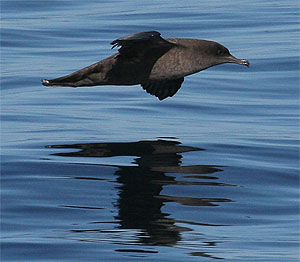 A single sooty shearwater flying just above the ocean surface at the Cordell Bank National Marine Sanctuary. You rarely see these birds alone. More typical are flocks consisting of hundreds or even thousands of birds. (Source: Steve N.G. Howell / Cordell Bank National Marine Sanctuary) Sooty shearwaters are dark gray birds with wingspans up to 43 inches across. They are related to albatrosses, and like these open-ocean travelers, the only time they come ashore is to nest. Also like the albatrosses, they have a keen sense of smell, which helps them detect schools of fish from miles away. Sooty Shearwaters nest in the Southern Hemisphere, but fly all the way to Monterey Bay to feed on the bounty of krill, anchovies, and market squid. Between March and May the entire population of sooty shearwaters (including newly fledged chicks) leaves their southern hemisphere nesting areas near New Zealand and Tierra del Fuego, just ahead of southern winter. By April or May, the first waves of sooty shearwaters are beginning to arrive on the Central Coast. Some shearwaters fly northward up the Pacific Coast of South and North America. These birds follow the same route as do the anchovies, sardines, juvenile sea lions, and whales heading up from Southern California. Another group of shearwaters flies straight across the Pacific, from New Zealand to California. The journey takes about two weeks, and the migrating birds do not stop to eat during this time. By the time they reach the Central Coast, the shearwaters are ravenous! Some of the shearwaters we see in May are just stopping by for a quick bite to eat. As spring becomes summer, the flocks of foraging shearwaters will leave Monterey Bay to migrate northward along the coast. By the end of June, shearwater flocks typically appear off Ocean Beach, San Francisco. They reach peak abundance at the Farallon Islands around the beginning of July. Some shearwaters fly as far north as Vancouver Island or Southeast Alaska in their never-ending search for food. Later in fall, some of the shearwaters will migrate south again. Thus, we often see two peaks in shearwater populations along the Central California coast—a first peak in April or May, as the birds migrate northward, and a peak second in August or September, when they migrate southward again. During their spring feeding stop in Monterey Bay, shearwaters feed on schools of young krill (especially Thysanoessa spinifera)and market squid, diving as deep as 30 to 50 feet below the surface in pursuit of prey. After their long journey, when the shearwaters do find rich supplies of food, the birds often gorge themselves. One researcher counted over 230 krill in the stomach of a single sooty shearwater. During April and May, shearwaters tend to forage farther from shore than they do later in the year. Strong upwelling currents in spring often carry the shearwaters' food (young krill) 5 to 15 miles offshore, so that's where you'll find the shearwaters as well. If upwelling is weak, however, the sooty shearwaters and their prey are likely to spend more time within Monterey Bay and close to shore. This is why you are more likely to see shearwaters from shore during the Fall months (as well as during El Nino years). 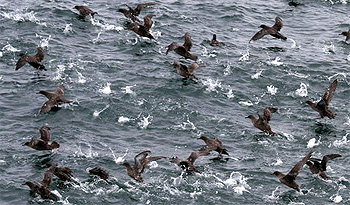 A portion of a flock of sooty shearwaters flying over the water at Cordell Bank National Marine Sanctuary. Such flocks often consisting of hundreds or even thousands of birds. During the afternoon hours, they are constantly on the move, looking for food or tracking schools of krill. (Source: Sophie Webb, SWFSC/NOAA) In the calm morning hours, flocks of shearwaters often float in huge rafts on the ocean surface, several miles off the coast. With the rising afternoon sea breeze, the shearwaters take off, forming long lines of birds that roam across the ocean searching for food. When they find a school of fish or krill, the birds fly in circles around the perimeter of the school, essentially "herding" the fish toward the center of the circle. Some of these wheeling flocks of shearwaters can be as much as a half mile across. Although their numbers vary from year to year, shearwaters are by far the most numerous birds on the Central Coast (at least from spring through fall). One researcher goes so far as to say that they are “the most numerous and cosmopolitan seabird in the Pacific Ocean.” It has been estimated that, during a typical June, half a million shearwaters feed in the waters of Monterey Bay alone. Even more impressive than the number of shearwaters is the number of fish and squid who must be present within Monterey Bay in order to support half a million shearwaters. I think of sooty shearwaters as the birds of the "Endless Summer," following the summer around the Pacific Ocean. But they are also the birds of the "endless migration"—always on the move, trying to find supplies of food large enough to support their immense flocks. Late spring migratory seabirds pass through By May, the great spring migration of land and shore birds is starting to taper off. The last birds in the spring migration typically pass along the Central Coast in early May. Arctic terns migrate through Among the last migrating birds to pass along the Central Coast are Arctic terns (Sterna paradisaea). Like sooty shearwaters, Arctic terns cross the entire Pacific, flying in a meandering course from feeding grounds in the Antarctic to feeding and nesting areas in the Arctic and back again over the course of a year. At over 44,000 miles, this is one of the longest known migrations of any animal on earth. One newly fledged (and banded) Arctic chick flew over 14,000 miles, from England to Australia, in the first three months of its life. During May you may see these small, graceful birds migrating northward along the coast or resting in the kelp beds. With a wingspan of 26-30 inches, they are noticeably smaller than Caspian or Forster's terns. They live for perhaps 30 years, and, with their extensive migrations, are found across most of the world's coastal areas. Although a few Arctic terns may be visible in May, the greatest number of Arctic terns visit the Central Coast in August, when they stop by during their southward migration, after nesting in the Arctic tundra of Northern Canada. Phalaropes migrate through During May, boaters plying the waters of Monterey Bay may see flocks of tiny red phalaropes (Phalaropus fulicarius) floating on or flying over the bay waters, the males in striking breeding plumage. Red phalaropes migrate northward in spring, flying mostly over the open ocean. The red phalaropes you see in May are heading north to the shores of the Arctic Ocean, where they will nest during the short Arctic summer. In fall they will migrate southward again to feeding grounds off the coast of Chile. Except when nesting, red phalaropes spend most of their time at sea. They hunt small fish, young krill, and copepods that congregate near the sea surface. Like Arctic terns, red phalaropes nest in the Arctic during the summer, and will pass through Monterey Bay in large numbers in September after nesting. Common murres incubate eggs 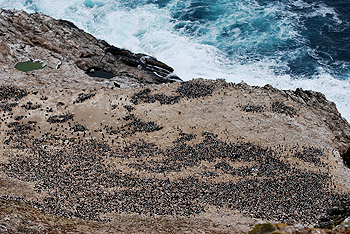 An immense colony of nesting murres (and a few Brandt's cormorants) on the Farallon Islands. There are tens of thousands of birds in this colony. (Source: KQED/QUEST) Aside from sooty shearwaters, common murres (Uria aalge) are probably the most abundant seabird on the Central Coast. During spring, common murres gather by the thousands to nest on offshore islands and a few isolated rocky headlands. By far the largest sea-bird nesting colonies along the Central Coast lie several dozen miles west of the Golden Gate, on the Farallon islands. During May, these rocky islands host raucous, densely packed colonies of up to 100,000 common murres—the largest murre colony in the continental United States. Much smaller groups of murres nest along rugged headlands and rocky islets along the Big Sur coast and near Devil's Slide, Marin Headlands, and Point Reyes. Note: During the 1800s, seabirds breeding on the Farallon Islands were nearly exterminated by egg hunters from San Francisco. After declining to only about 6,000 birds by 1950, the number of nesting murres has increased dramatically. But even today's impressive gatherings of murres are estimated to only about one fifth as large as those that existed before the California gold rush. Common murres often share their colonies with nesting Brandt’s cormorants and Western gulls, as well as with other non-nesting birds such as Heerman’s gulls, Brown Pelicans, and Black turnstones. The murres seem to favor the most exposed parts of the rocky islands—-those that are buffeted by the continuous fury of the spring northwest winds. During the beginning of the nesting season, in April and early May, common murres feed on krill, market squid, and herring. Herring in particular may be abundant at this time of year around the Gulf of the Farallones, having just left their nursery areas in estuaries such as San Francisco Bay. As the summer progresses, the murres will switch to eating the juveniles of spring-spawning rockfish (which are just being released as larvae in April and May). Auklets incubate eggs 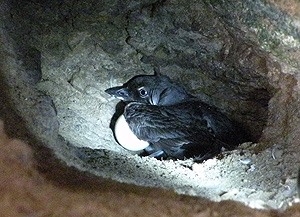 A Cassin's auklet in its burrow. (Source: Darrell Whitworth / California Institute of Environmental Studies) In contrast to the crowded, noisy colonies of common murres, some seabirds do their best to make their nesting process invisible. Rhinoceros auklets (Cerorhinca monocerata) and Cassin's auklets (Ptychoramphus aleuticus), for example, build their nests in burrows underground and only emerge at night to hunt for food. These reclusive birds dig tunnels up to 14 feet long into soft soil or sand on the Farallones and Ano Nuevo islands. During a typical year, 40,000 Cassin's Auklets (Ptychoramphus aleuticus) and 1,000 rhinoceros auklets (Cerorhinca monocerata) nest on the Farallon Islands, while 100 to 200 rhinoceros auklets nest on Ano Nuevo Island.. Note: Auklets were unable to breed on the Farallon Islands for almost 100 years because of competition for burrows from rabbits that were introduced to the islands. However, when the rabbits were removed in 1973, the auklets began nesting again the following year. Cassin's auklets About 80% of the California population of Cassin's auklets nest on the Farallon Islands. After laying a small clutch of eggs, Cassin's auklets spend their long incubation period—up to 48 days—taking turns sitting on the eggs and flying out to forage in the deep water around the islands. During the nesting season, the birds may only approach the nest at night to avoid the attention of Western Gulls. Cassin's auklets eat mostly krill, especially the relatively large krill known as Thysanoessa spinifera (which is also a favorite of blue whales). Swarms of young krill are particularly abundant around the Farallon Islands in May, when the auklets are nesting. Auklets nesting at the Farallon Islands may travel as far as Monterey Bay to find dense swarms of krill. Rhinoceros auklets Rhinoceros auklets typically forage at night, diving hundreds of feet below the ocean surface to hunt sablefish and other small fishes that frequent the outer continental shelf. These diminutive birds also hunt nocturnal predators such as juvenile lingcod, which are just settling into the kelp beds in May. Rhinoceros auklets incubate their eggs for a long time--about a month and a half. After the young auklets hatch (typically in mid June) they may remain in their burrow for another month. Both adults and young are relatively small, and even adults may be attacked by Western Gulls. Cormorants incubate eggs By May, many Brandt's cormorantshave finished building their sturdy, volcano-shaped nests on exposed rock ledges or old piers. The females have settled down in their nests with only their necks and heads showing, while the male cormorants stand around nervously and chase away Western gulls that swoop low and viciously attack any exposed egg or chicks. It's hard to see the eggs in a Brandt's cormorant's nest because they are hidden beneath the female's body, which fits exactly within the nest itself. Even after the chicks hatch, they may remain huddled underneath their mother's body for a week or two, for protection from marauding gulls. Only when the male cormorant returns to the nest to feed the young can you sometimes see the tiny, snake-like necks and heads of the newly hatched cormorants sticking out from under the female's belly. After returning from a foraging flight, the male cormorants jabs his rapier-sharp bill directly into the mouths of the hungry chicks, then regurgitates a slurry of predigested fish into each chick's mouth. By the end of May, some of the chicks will have grown to the size of small chickens, and you can see them walking awkwardly around the nesting areas. Pelagic cormorants can also be seen nesting in May. However, their nests are more difficult to see, because they are located in tall trees or on isolated sea cliffs. They also do not usually nest in dense colonies as do the Brandt's cormorants. Western gulls incubate eggs Western gulls (Larus occidentalis often build their nests close to the nests of cormorants and other sea birds. But they are far from good neighbors. The gulls keep a close eye on neighboring nests, and will eat any eggs and young birds that are left unprotected for even a few seconds. Apparently this extra source of protein helps the adult gulls to survive the rigors of the nesting season. Like cormorants, Western gulls may arrive as early as February or March to claim prime nesting spots. By May, they will have created rough nests of vegetation, twigs, and feathers. In these nests, the females will have laid two or three lightly speckled, 3-inch-long eggs. The females will incubate their eggs (and guard them from other hungry gulls) for about 25 days. Note: In a typical south-to-north progression, Western gulls in Southern California usually lay eggs about 3 weeks before those in Central or Northern California. By the end of May, you may see the first Western gull chicks emerging from their nests. Unlike cormorants, gull chicks leave the nest shortly after hatching, and soon begin walking around and exploring the area around their nests. With their fluffy bodies, stiff-legged gait, and stubs of wings, the gull chicks look ungainly and faintly preposterous, like the armless humans (Hammerheads) described by L. Frank Baum in the Wizard of Oz. Pigeon guillemots incubate eggs 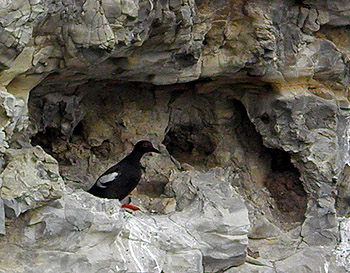 An pigeon guillemot stands on the "front porch" of its burrow on a sea cliff. In many cases the entrances to guillemot burrows are impossible to see because of overhanging vegetation. (Source: Kim Fulton-Bennett) Although you often see pigeon guillemots flying out over the kelp beds in May, you won't see their nests. Tucked into crevices and burrows in coastal bluffs, the nests are relatively safe from gull attacks, but they are still susceptible to invasion by rats, and in some cases displacement by real pigeons. You are mostly likely to see guillemots as they launch themselves from the vertical face of a cliff and go arcing out over the nearshore waters, issuing rapid, high-pitched squeaks. If you see a guillemot heading back toward shore with a fish in its beak, keep an eye on it. You may be able track it long enough to see it disappear into its burrow. However, guillemots often fly right up to a cliff face only to veer off at the last moment. Perhaps this maneuver is designed to confuse predators. By May, each nesting female guillemot will have laid one or two eggs. Tan to light green with black splotches, the eggs blend perfectly with the dirt and vegetation of the seacliffs. The male and female guillemots take turns incubating the eggs and flying out to forage for seafloor animals just beyond the kelp beds. Pairs of nesting guillemots take turns incubating their eggs and flying out beyond the kelp beds to forage for small fish such as sculpin or juvenile rockfish. Once their eggs hatch, the parents may make 15 to 20 trips a day to feed their young, since they can only catch and carry one fish at a time. Like many seabirds, pigeon guillemots go through boom and bust cycles. During years when food is scarce (such as El Nino years), guillemots may mate and build nests but be unable to lay any eggs. Note: You can read more about nesting guillemots on the web page about seabirds in April. Black oystercatchers incubate eggs Another coastal bird that nests on Central Coast seacliffs in May is the black oystercatcher. You can often see pairs of oystercatchers standing on intertidal rocks, calling to defend their territory. However, it is very hard to spot oystercatcher nests, which are tucked into rocky ledges just above the reach of the waves. The male oystercatcher builds the nest, scraping out a shallow bowl-shaped pit then lining it bits of shell and small stones. The female then lays two to three tan eggs with brownish spots. For about a month, both parents incubate the eggs and defend them from gulls. If disturbed by humans or dogs, the oystercatchers will fly away, leaving the nest highly vulnerable to gull attacks. A pair of oystercatchers typically forages along one specific section of coast, and may use the same nesting site year after year. Cliff swallows nest on sea cliffs Though not sea birds, cliff swallows often nest along sea cliffs, especially near the mouths of coastal streams. They often nest in large colonies. Starting in April, you may see them building their little pocket-like mud nests on vertical or even overhanging rock cliffs. Each morning and late afternoon, swarms of swallows emerge from their nests and swoop back and forth, gathering insects on the wing. By the end of May, you may see adult swallows return to the openings of their nests and poke food into the tiny mouths of their newborn chicks. Caspian terns nest near wetlands While some seabirds nest along rocky cliffs, Caspian terns (Sterna caspia) prefer to nest on small islands or sandbars in coastal wetlands and rivermouth areas. By May, the Caspian terns that arrived in March and built nests in April will have laid two or three spotted, light brown eggs. Caspian terns incubate their eggs for only about 25 days, so the young chicks typically hatch by the end of May. If their nesting site is disturbed, the Caspian terns may try nesting again in June. In Elkhorn Slough and San Francisco Bay, Caspian terns nest on isolated islands and broken dikes (especially those protected by tidal channels that are at least 1 to 2 feet deep at low tide). Such areas offer some protection from raccoons, skunks, rats, and dogs. But it only takes one extreme low tide or channel collapse for such areas to become accessible to quadrupeds. In this case, entire nesting colonies may be decimated in a single night. Forster's terns build nests near wetlands Forster's terns (Sterna forsteri) arrive on the Central Coast a little later than Caspian terns. In May they begin building their nests near Elkhorn Slough and the southern San Francisco Bay in May. Historically, Forster's terns nested on the shores of freshwater lakes and river beds, but they have adapted to nesting on abandoned human structures such as broken dikes and dredge spoil areas. Unlike Caspian terns, which scrape pits in the dirt for nests, Forester's terns build neat little nests out of marsh vegetation such as Frankenia (alkali heath) or pickleweed. Although Forster's terns begin nesting a little later than Caspian terns and other birds in the slough, they have shorter incubation time and their young develop quite rapidly. Thus, the young Forster's terns fledge at about the same time as other local seabirds (in July). This allows both the adult and young terns to feed on the legions of small fish (such herring, anchovies, and sculpin) that leave coastal wetlands for coastal waters between May and July. |
